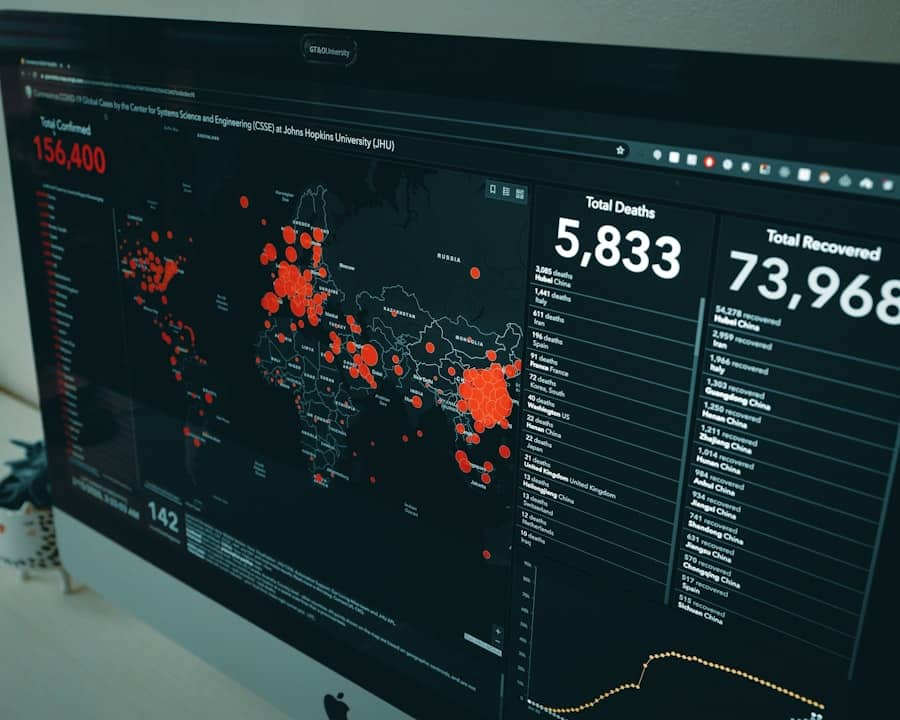In an era where cyber threats are becoming increasingly sophisticated, organizations are turning to advanced technologies to bolster their security measures. Among these technologies, artificial intelligence (AI) has emerged as a pivotal player in the realm of security analytics. AI-powered security analytics leverages machine learning algorithms and data analysis techniques to identify, assess, and mitigate risks in real-time.
This innovative approach not only enhances the ability to detect anomalies but also streamlines the response to potential threats, making it an indispensable tool for modern cybersecurity frameworks. The integration of AI into security analytics represents a paradigm shift in how organizations approach risk management. Traditional security measures often rely on predefined rules and signatures to identify threats, which can be insufficient in the face of evolving attack vectors.
In contrast, AI systems can learn from vast amounts of data, adapting to new patterns and behaviors that may indicate a security breach. This capability allows organizations to stay one step ahead of cybercriminals, ensuring that their defenses are not only reactive but also proactive in nature.
Key Takeaways
- AI-powered security analytics use artificial intelligence to analyze and detect potential risks and threats in a more efficient and effective manner.
- AI plays a crucial role in risk detection by continuously learning and adapting to new patterns and anomalies, enabling organizations to stay ahead of potential security breaches.
- The benefits of AI-powered security analytics include improved threat detection, faster response times, and reduced false positives, ultimately leading to enhanced overall security posture.
- Case studies have shown how AI-powered security analytics have significantly improved risk detection by identifying and mitigating threats that traditional methods may have missed.
- While implementing AI-powered security analytics may come with challenges such as data privacy concerns and integration issues, organizations can overcome these obstacles by following best practices and leveraging the latest technologies.
Understanding the Role of AI in Risk Detection
At the core of AI-powered security analytics is the ability to process and analyze large datasets at unprecedented speeds. Machine learning algorithms can sift through logs, network traffic, and user behavior data to identify patterns that may signify a security threat. For instance, an AI system can analyze user login attempts across a network and flag any unusual activity, such as multiple failed logins from different geographic locations within a short time frame.
This level of analysis is beyond the capabilities of traditional systems, which may only trigger alerts based on static rules. Moreover, AI can enhance risk detection through anomaly detection techniques. By establishing a baseline of normal behavior within an organization’s network, AI systems can identify deviations that may indicate malicious activity.
For example, if an employee typically accesses files during business hours but suddenly begins downloading large amounts of data late at night, the AI system can flag this behavior for further investigation. This dynamic approach to risk detection not only improves accuracy but also reduces the number of false positives that often plague traditional security systems.
The Benefits of AI-Powered Security Analytics

The advantages of implementing AI-powered security analytics are manifold. One of the most significant benefits is the enhancement of threat detection capabilities. By utilizing machine learning algorithms, organizations can detect threats that may go unnoticed by conventional methods.
This increased visibility into potential risks allows for quicker response times and more effective mitigation strategies. Additionally, AI-powered systems can significantly reduce the workload on security teams. With automated threat detection and analysis, security professionals can focus their efforts on more complex tasks that require human intervention.
For instance, rather than spending hours sifting through logs to identify potential threats, analysts can leverage AI tools to highlight critical incidents that require immediate attention. This not only improves efficiency but also allows organizations to allocate their resources more effectively. Another notable benefit is the continuous learning aspect of AI systems.
As these systems process more data over time, they become increasingly adept at identifying new threats and adapting to changing attack methodologies. This adaptability is crucial in a landscape where cyber threats are constantly evolving. Organizations that implement AI-powered security analytics can thus maintain a robust defense posture against emerging risks.
Case Studies: How AI-Powered Security Analytics Have Improved Risk Detection
Several organizations have successfully implemented AI-powered security analytics to enhance their risk detection capabilities, yielding impressive results. One notable example is a major financial institution that faced challenges with detecting fraudulent transactions amidst a high volume of legitimate activity. By integrating an AI-driven analytics platform, the institution was able to analyze transaction patterns in real-time, identifying anomalies that indicated potential fraud.
The system learned from historical data and continuously refined its algorithms, resulting in a significant reduction in false positives and an increase in the detection rate of actual fraudulent activities. Another compelling case study involves a healthcare organization that sought to protect sensitive patient data from cyber threats. The organization deployed an AI-powered security analytics solution that monitored network traffic and user behavior across its systems.
By employing machine learning techniques, the system was able to detect unusual access patterns to patient records, alerting the security team to potential breaches before they could escalate. This proactive approach not only safeguarded patient information but also ensured compliance with regulatory requirements regarding data protection.
Overcoming Challenges in Implementing AI-Powered Security Analytics
Despite the clear benefits of AI-powered security analytics, organizations often face challenges during implementation. One significant hurdle is the integration of AI systems with existing security infrastructure. Many organizations have legacy systems that may not be compatible with modern AI technologies, leading to potential gaps in security coverage.
To address this issue, organizations must carefully assess their current infrastructure and develop a comprehensive integration strategy that ensures seamless communication between new AI tools and existing systems. Another challenge lies in the quality and quantity of data available for training AI models. Machine learning algorithms require vast amounts of high-quality data to function effectively.
Organizations must ensure that they have access to relevant datasets and that these datasets are clean and well-structured. Additionally, there may be concerns regarding data privacy and compliance with regulations such as GDPR or HIPAA when utilizing sensitive information for training purposes. Organizations must navigate these complexities while ensuring that their AI systems remain effective and compliant.
The Future of AI-Powered Security Analytics in Risk Detection

Looking ahead, the future of AI-powered security analytics appears promising as technology continues to evolve. One anticipated trend is the increased use of predictive analytics within security frameworks. By leveraging historical data and advanced algorithms, organizations will be able to forecast potential threats before they materialize, allowing for preemptive measures to be taken.
This shift from reactive to proactive security strategies will fundamentally change how organizations approach risk management. Furthermore, as AI technologies advance, we can expect greater collaboration between human analysts and AI systems. Rather than viewing AI as a replacement for human expertise, organizations will increasingly recognize the value of combining human intuition with machine intelligence.
This hybrid approach will enhance decision-making processes and improve overall security outcomes.
Best Practices for Implementing AI-Powered Security Analytics
To maximize the effectiveness of AI-powered security analytics, organizations should adhere to several best practices during implementation. First and foremost, it is essential to establish clear objectives for what the organization aims to achieve with AI integration. Whether it’s improving threat detection rates or reducing response times, having defined goals will guide the implementation process.
Additionally, investing in training for security personnel is crucial. As AI technologies evolve, so too must the skills of those who operate them. Providing ongoing education and training will empower security teams to leverage AI tools effectively and make informed decisions based on insights generated by these systems.
Organizations should also prioritize data governance as part of their implementation strategy. Ensuring that data used for training AI models is accurate, relevant, and compliant with regulations will enhance the reliability of the insights generated by these systems.
The Impact of AI-Powered Security Analytics on Risk Detection
The integration of AI-powered security analytics into risk detection frameworks represents a transformative advancement in cybersecurity practices. By harnessing the power of machine learning and advanced data analysis techniques, organizations can significantly enhance their ability to identify and respond to threats in real-time. As demonstrated through various case studies, the successful implementation of these technologies has led to improved detection rates and reduced workloads for security teams.
As organizations continue to navigate an increasingly complex threat landscape, embracing AI-powered solutions will be essential for maintaining robust security postures. By overcoming implementation challenges and adhering to best practices, organizations can unlock the full potential of AI in safeguarding their assets against evolving cyber threats. The future holds great promise for those willing to invest in these innovative technologies, paving the way for a more secure digital environment.
In the rapidly evolving landscape of cybersecurity, AI-powered security analytics have become a cornerstone for enhancing risk detection and response strategies. These advanced systems leverage machine learning algorithms to identify potential threats and vulnerabilities with unprecedented accuracy and speed. For those interested in exploring how technology is transforming other sectors, the article on Unlock the Possibilities with Galaxy Book2 Pro 360 provides insights into the integration of cutting-edge technology in consumer electronics, showcasing how innovation continues to drive progress across various industries.
FAQs
What is AI-powered security analytics?
AI-powered security analytics refers to the use of artificial intelligence and machine learning algorithms to analyze and detect security threats and risks within an organization’s network and systems. This technology can help identify and respond to potential security incidents more effectively and efficiently.
How does AI-powered security analytics improve risk detection?
AI-powered security analytics can improve risk detection by continuously monitoring and analyzing large volumes of data to identify patterns and anomalies that may indicate potential security threats. This technology can also automate the process of identifying and prioritizing security risks, allowing organizations to respond more quickly and effectively to potential threats.
What are the benefits of using AI-powered security analytics for risk detection?
Some of the benefits of using AI-powered security analytics for risk detection include improved accuracy in identifying potential security threats, faster response times to security incidents, and the ability to analyze and process large volumes of data more efficiently. Additionally, AI-powered security analytics can help organizations reduce the burden on human analysts and improve overall security posture.
What are some common use cases for AI-powered security analytics in risk detection?
Common use cases for AI-powered security analytics in risk detection include identifying and responding to insider threats, detecting and mitigating advanced persistent threats (APTs), and analyzing network traffic to identify potential security vulnerabilities. Additionally, AI-powered security analytics can be used to monitor and analyze user behavior to identify potential security risks.

